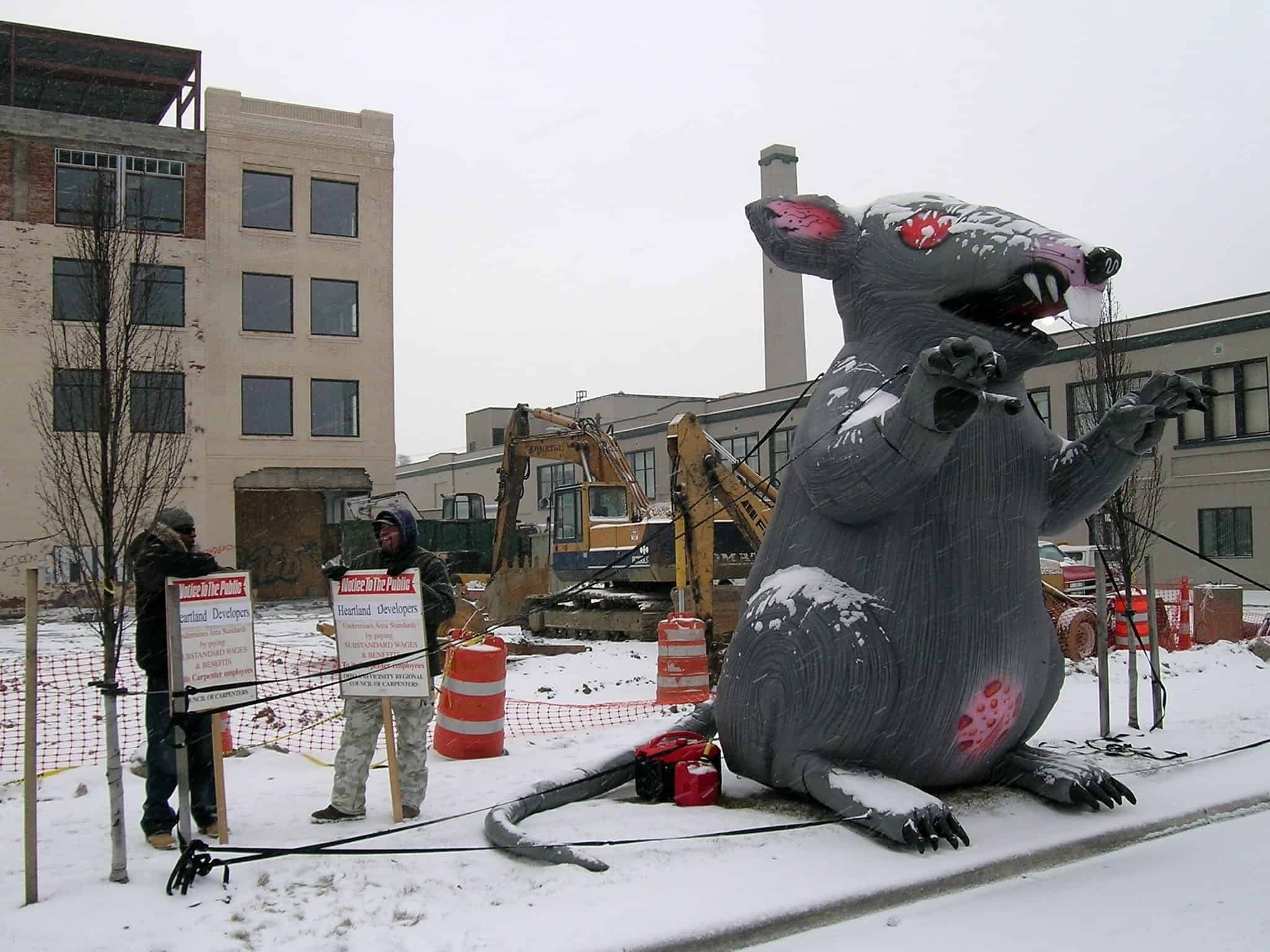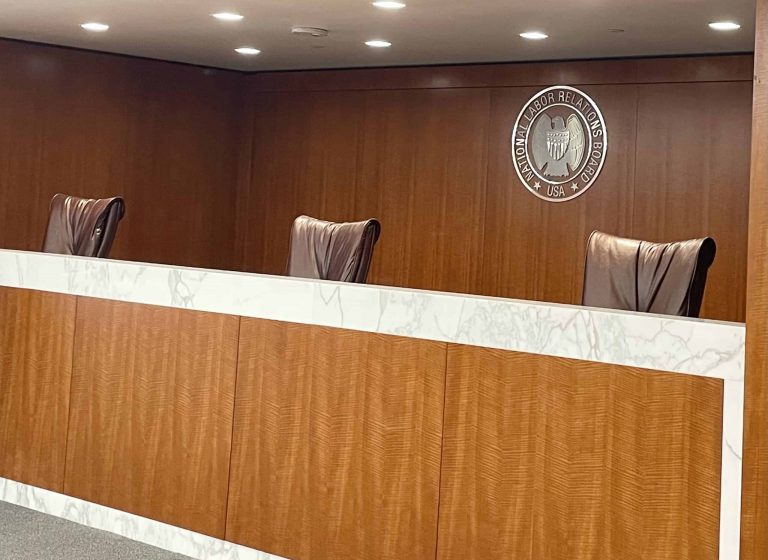
Marina Multhaup is a Senior Associate at Barnard, Iglitzin & Lavitt—a law firm in Seattle, Washington, that represents unions, and a former student member of the Labor and Employment Lab at Harvard Law.
What has sharp teeth, blood-shot eyes, festering nails, looms twelve feet tall, but doesn’t look mean enough to be threatening? Though it might seem like an unlikely subject of cutting-edge labor and constitutional law, the union’s inflatable rat balloon called Scabby has been at the center of these disputes for over a decade. Scabby has survived lawsuits, injunctions, unfair labor practice accusations, and even friendly fire. But Scabby faced its biggest threat yet when President Trump’s General Counsel Peter Robb set his sights on the rat in 2017. Though Robb allegedly “wanted the rat dead,” Scabby managed to stay alive. How has Scabby survived the anti-union legal climate for so long? And who cares?
Unions have been using inflatables as protest tools since the 1970s, but the Scabby that we know and love wasn’t born until 1990. A Chicago bricklayers union asked a local balloon-making company, Big Sky Balloons, to design a large inflatable rat. Peggy O’Connor, the owner of Big Sky Balloons, remembers that the bricklayers specifically requested that the rat look “mean…with festering nails and teeth,” in order to “send a strong message during protests.” Ms. O’Connor’s first attempt “wasn’t mean enough,” so she added red bloodshot eyes and a scabbed pink belly. The bricklayers loved it, and Scabby was an instant hit. Unions all over the country started requesting Scabby’s from Big Sky. Today, Big Sky sells around 40-50 Scabby balloons a year, ranging from six feet to 25 feet high, priced from $2,585 to $9,295, sold with a blower and an extension cord.
Scabby is deployed by unions in order to publicize a labor dispute, either with a so-called primary employer or with another employer involved in the dispute. Scabby has been declared legal and protected by the First Amendment in the primary dispute context. For example in Tucker v. City of Fairfield, the Sixth Circuit explained, “In our view, there is no question that the use of a rat balloon to publicize a labor protest is constitutionally protected expression within the parameters of the First Amendment.” In another case a New York district court “easily concluded” that a “large inflatable rat is protected, symbolic speech.”
Scabby’s nest of legality becomes more complicated when it’s stationed outside of a so-called “neutral” or “secondary” employer as it then gets entangled in the NLRA’s complicated secondary boycott prohibition at §8(b)(4). In Safeco, the Supreme Court held that consumer picketing by a union urging a general boycott of a secondary employer was proscribed under §8(b)(4). The Court avoided First Amendment problems by declaring that picketing was “a mixture of conduct and communication” and it was the conduct element that deterred consumers from the secondary employer. Then in DeBartolo the Supreme Court held that peaceful handbilling outside of a secondary employer was protected by the Act. This left Scabby in a dimly-lit legal tunnel: is Scabby more like picketing or handbilling?
The Board first spoke to this issue in its 2010 Eliason decision where it considered whether stationary banners displayed outside secondary employers was a violation of §8(b)(4). In a divided opinion, the Board majority declared that the identifying element of picketing was not the holding of signs but rather when union members patrolled back and forth outside a business, creating a “physical or at least symbolic confrontation.” Under this definition of picketing, stationary banners were distinguishable, having none of the “coercive character” of picketing.
A year later the Board protected Scabby under this standard in Brandon. The 2011 Brandon Board first considered whether Scabby independently violated the “threaten, coerce, or restrain” provision of §8(b)(4)(ii). The Board found that Scabby did not, because there was nothing in the “location, size, or features” of the balloon that would frighten, disturb, or interfere with people entering the secondary employer location. Next, the Board found that Scabby was not picketing under the Eliason standard because Scabby was stationary, it couldn’t patrol back and forth, it didn’t form a symbolic or physical confrontation. Lastly, the Board found that protecting Scabby under the Act was strongly supported by the constitutional avoidance doctrine.
However, Scabby’s fate wasn’t totally secured. The Board’s dissent in Brandon laid out a road map for how to declare Scabby illegal, should the opportunity arise. The dissent disagreed that the patrol element was the defining aspect of picketing. The dissent thought that picketing could simply be the “confrontational posting of a union agent at a neutral employer’s premises.” Under that definition of picketing, Scabby would be in trouble. The dissent also argued that Scabby’s presence independently violated the “threaten, coerce, or restrain” provision—a giant, 14-foot inflatable rat balloon, looming over the sidewalk, with bloodshot eyes, festering nails, and sharp teeth? Threatening!
Indeed, when Trump appointed Peter Robb as General Counsel of the NLRB, Robb instructed none other than Peter Ohr, then regional director of the Chicago NLRB and current acting General Counsel, to revive a previously-dismissed complaint by an Illinois demolition company involving Scabby. This started a round of Scabby-related litigation that Robb hoped would conclude in a more expansive definition of picketing and an end to Scabby. After an ALJ found that Scabby did not constitute picketing or otherwise coercive activity under §8(b)(4), Robb invited briefs on the question of whether Scabby (and bannering) should nonetheless be proscribed. Robb asked whether the Board should overrule Eliason and Brandon, alter its standard for determining what conduct constitutes picketing, alter its standard for determining what behavior is otherwise unlawfully coercive, and if so, how it could do all that without running afoul of the First Amendment. Dozens of amicus briefs were submitted on the question and the issue was live going into 2021.
Just when Scabby’s fate looked dire, newly-elected President Biden fired Robb and promoted Peter Ohr. Having previously been forced to be Scabby’s executioner, in February Ohr stepped in to offer hope. Ohr filed motions to dismiss the two Scabby cases that are pending before the Board, and wrote that “such pursuit is a waste of valuable Agency resources and not in the public interest.” The Board hasn’t yet ruled on Ohr’s motions to dismiss, and of the four current members only Chairman McFerran dissented from the Board’s original Notice and Invitation to File Briefs on the issue. Inauspiciously, the Board granted the Associated Builders and Contractors leave to file an amicus in opposition to the GC’s motion to dismiss. The amicus was due April 7 and it is unclear how the Board will rule.
All of that still doesn’t answer the question, who cares about a big rat? Employers, management, and their lawyers care about Scabby. An insider reported that Robb “hates the rat.” Reporters Sarah Jaffe and Molly Crabapple reported that “on three different occasions, the rats have been stabbed by angry representatives of management.” Unions also care deeply about the rat. Scabby doesn’t only represent the existence of a labor dispute, but it is also “part of labor’s internal culture, a lifestyle under siege.” Scabby was created “through the collective consciousness brought about by decades of struggle,” and its presence “is a clear signal to the public that management is attacking its workforce.” Though Scabby’s symbolic power is clear to both sides, Scabby’s legal footing remains uneasy.









Daily News & Commentary
Start your day with our roundup of the latest labor developments. See all
July 14
More circuits weigh in on two-step certification; Uber challengers Seattle deactivation ordinance.
July 13
APWU and USPS ratify a new contract, ICE barred from racial profiling in Los Angeles, and the fight continues over the dismantling of NIOSH
July 11
Regional director orders election without Board quorum; 9th Circuit pauses injunction on Executive Order; Driverless car legislation in Massachusetts
July 10
Wisconsin Supreme Court holds UW Health nurses are not covered by Wisconsin’s Labor Peace Act; a district judge denies the request to stay an injunction pending appeal; the NFLPA appeals an arbitration decision.
July 9
the Supreme Court allows Trump to proceed with mass firings; Secretary of Agriculture suggests Medicaid recipients replace deported migrant farmworkers; DHS ends TPS for Nicaragua and Honduras
July 8
In today’s news and commentary, Apple wins at the Fifth Circuit against the NLRB, Florida enacts a noncompete-friendly law, and complications with the No Tax on Tips in the Big Beautiful Bill. Apple won an appeal overturning a National Labor Relations Board (NLRB) decision that the company violated labor law by coercively questioning an employee […]